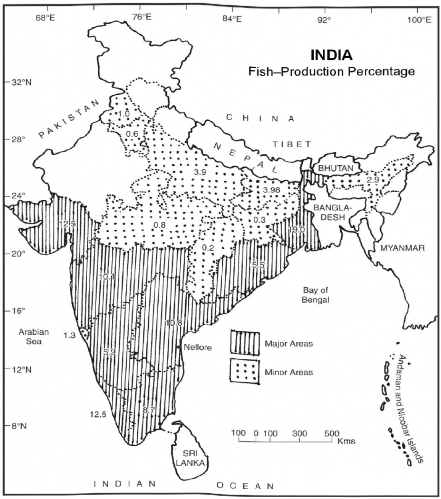BLUE REVOLUTION
Blue Revolution means tire adoption of a package programme to increase the production of fish and marine products. The Blue Revolution in India was started in 1970 during the Fifth Five-Year Plan when the Central Government sponsored the Fish Farmers Development Agency (FFDA). Subsequently, the Brakish Water Fish Farms Development Agency were set up to develop aquaculture. The Blue Revolution has brought improvement in aquaculture by adopting new techniques of lish breeding, fish rearing, fish marketing, and fish export. Under the Blue Revolution programme, there had been a tremendous increase in the production of shrimp. Andhra Pradesh and Tamil Nadu have developed shrimp in a big way. The Ncllore District of Andhra Pradesh is known as the ‘Shrimp Capital of India’.
There are more than 1800 species of fish found in the sea and inland waters of India, of which a very few are commercially important. The important sea fish include catfish, herring, mackerels, perches, mullets, Indian salmon, shell fish, eels, anchovies, and dorab. Similarly, the main fresh water fish include catfish, loaches, perches, eels, herrings, feather backs, mullets, carps, prawns, murrels, and anchovies. The production of fish in the country has been shown in Table 9.16, while Fig. 9.21 shows the statewise percentage- production of fisheries.
Table 9.16 India—Fish Production (production in million tonnes)
Year | Marine Fish | Inland Fish | Total |
1950-51 | 0.535 | 0.240 | 00.75 |
1970-71 | 10.86 | 6.75 | 17.56 |
1990-91 | 23.00 | 15.36 | 38.36 |
2000-2001 | 28.11 | 23.23 | 56.75 |
2010-2011 | 29.89 | 48.62 | 78.51 |
Source: India 2012, pp 118-119.

Fig. 9.21 Percentage of Fish Production (2005-06)
It may be observed from Table 9.16 that the fish production in the country has increased from 0.75 million tonnes in 1950-51 to 68.69 million tonnes in 2006- 2007. Fishing, aquaculture and a host of allied activities, a source of livelihood to over 14 million people as well as a major foreign exchange earner, in 2005-06 contributed about one per cent of the total GDP and 5.3 per cent of the GDP from agriculture sector.
The geographic base of Indian marine fisheries has 8118 km coastline, 2.02 million sq of Exclusive Economic Zone including 0.5 million sq km of continental shelf, and 3937 fishing villages. There are 189 traditional fish landing centres, 59 minor fishing harbours, which serve as bases for about 2,80,000 fishing craft consisting of 1,81,000 non-motorised traditional craft and 54,000 mechanised boats. Out of 180 deep sea fishing vessels, only 60 are in operation at present.
About 50 per cent of the country’s total fish production comes from the inland fisheries including the freshwater fisheries like ponds, tanks, canals, rivers, reservoirs, and fresh water lakes.
Marine fisheries contribute about 50 per cent of the total fish production of the country. Kerala is the leading producer followed by Maharashtra, Karnataka, Gujarat, and Goa. The fishing season extends from September to March. The higher fish production in the Arabian Sea is due to the broader continental shelf. The important fish varieties include sardines, mackerel and prawn.
The East Coast contributes about 28 per cent of the total production of marine fish in the country. The fishing activity along the East coast is mainly carried on from Rameswaram in the south to Ganjam in the north, with fishing season from September to April along the Coromandal Coast.
The National Fisheries Development Board has been set up to realise the untapped potential of fishery sector with the application of modern tools of research and development including biotechnology.
